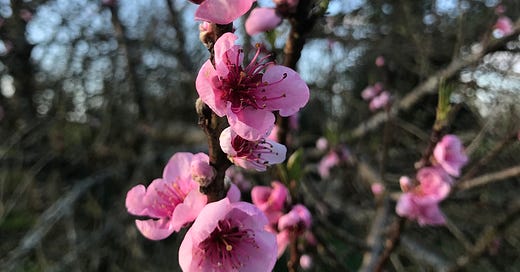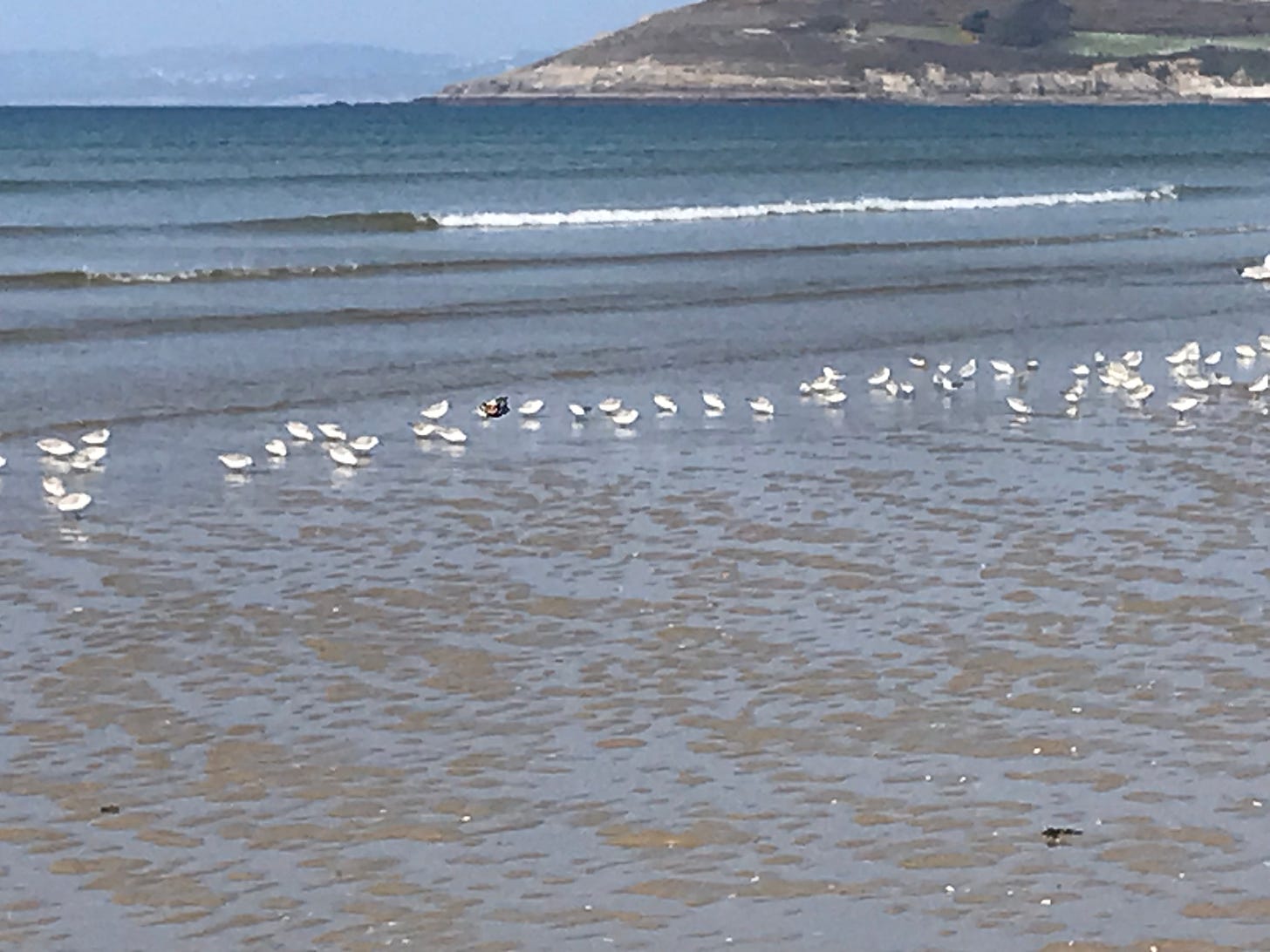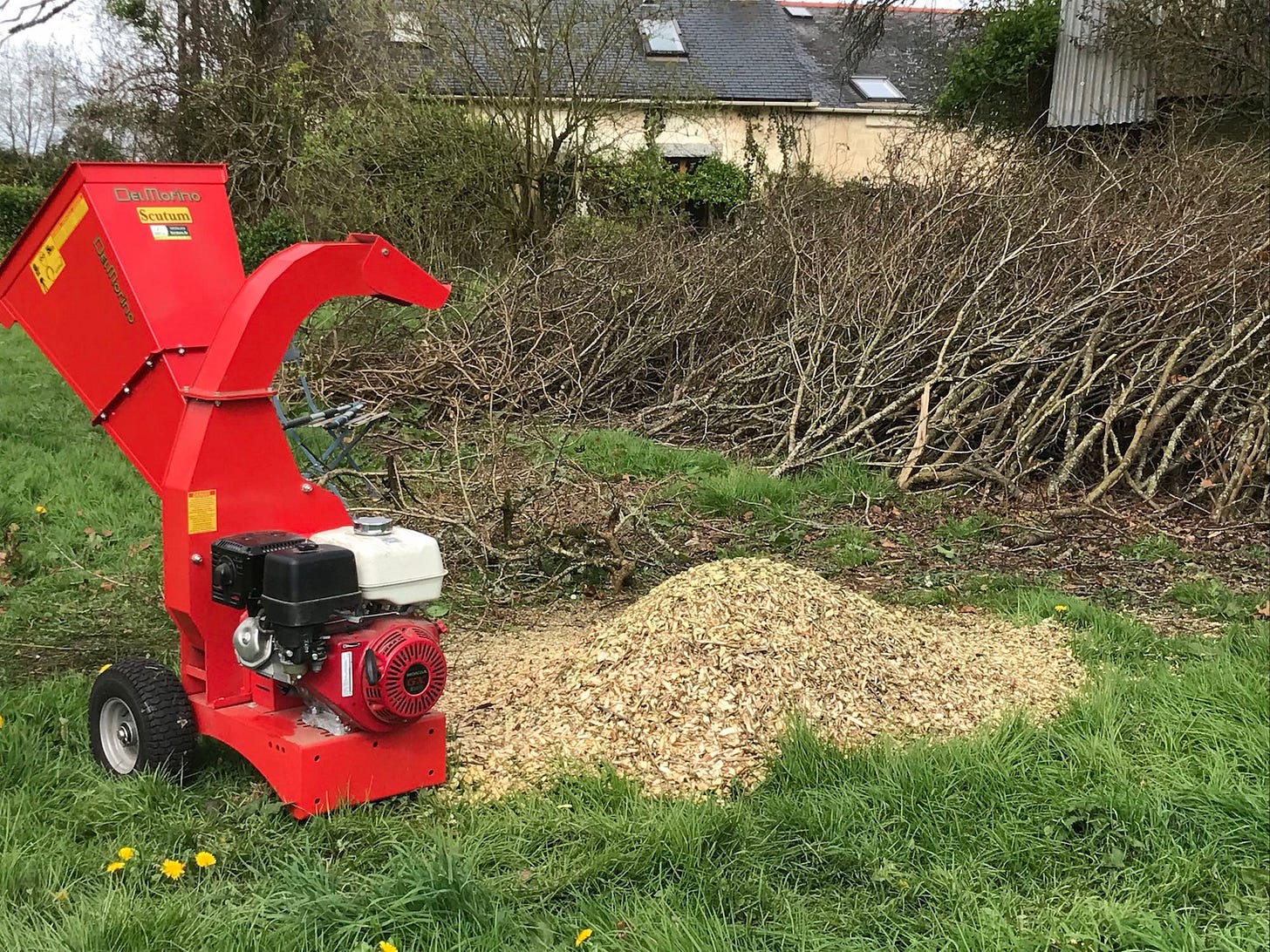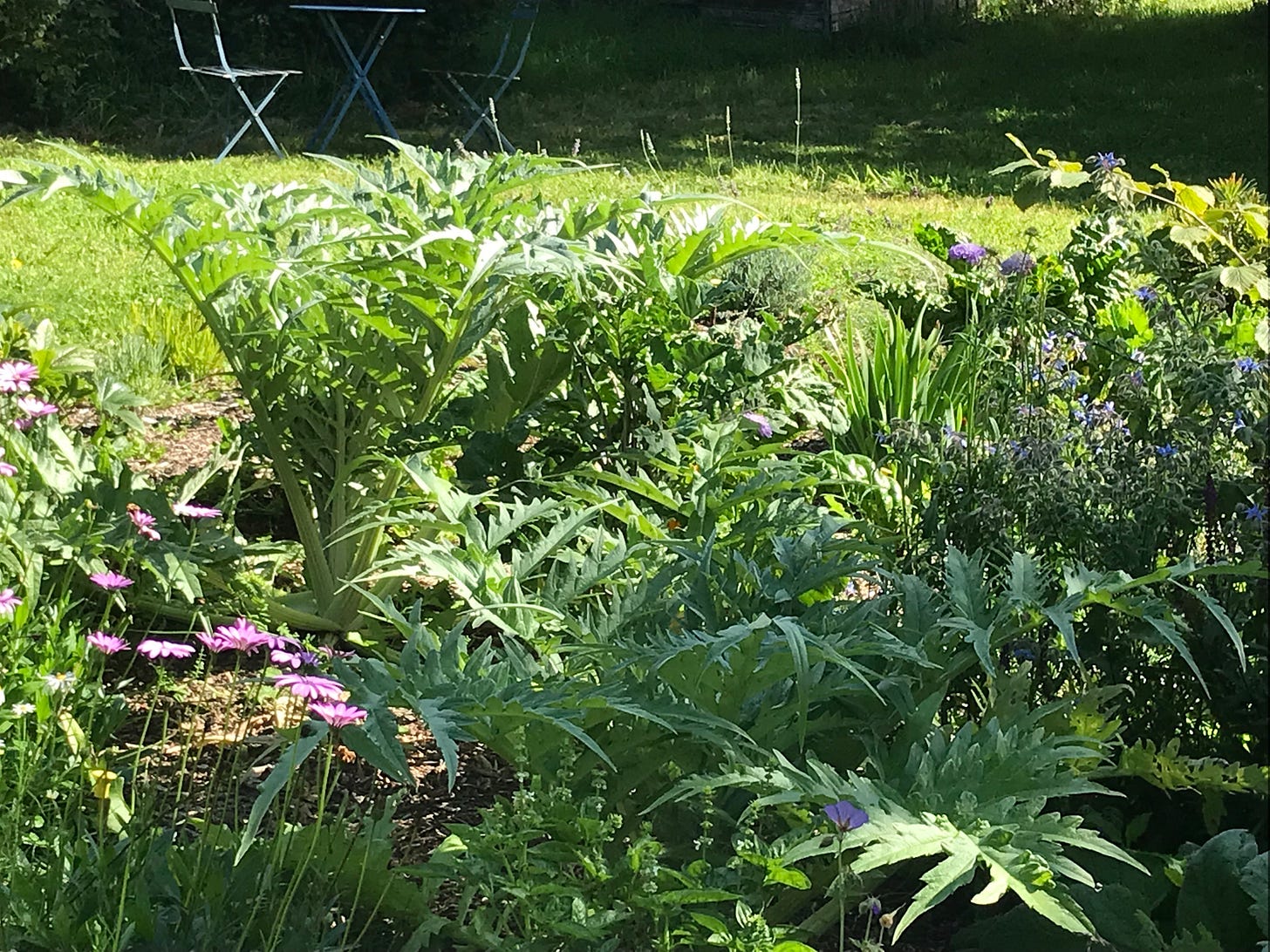Blossom & birds
When we first moved here, I had no idea that this was what peach blossom looked like; and it is right outside the kitchen. (And yes, we have peaches from it, even in northern Brittany.) I see that I posted this image last March, just after the equinox; and today, just before it, it will need two or three days to catch up with this image from last year.
Every day for the last month, stepping outside I have the full ocean-song of starling voice from one of the oaks. When they are static, in their hundreds, in a tree, they’re not a murmuration; I gather other collective nouns for them include an affliction (which they are not), a chattering (it’s more beautiful than that), and a constellation (pretty enough but not accurate). I call them a rivering of starling when they sing like this. What joy. What a backdrop to a day.
Sometimes it’s the small pleasures that keep us sane, isn’t it? The little reminders of the scale of the beauty in our world, on our planet, despite. Or perhaps because of. (With individuals whom I sometimes mentor, often at times of grief, we set up a base practice of noticing and recording, and of being grateful for the small daily miracles that are hidden in plain sight all around us.) So actually having managed to persuade The Man to take a whole morning off and come with me to the Atlantic coast in beautiful sun, to an immense nearly-empty-of-humans spring-tide beach at low ebb, where 100s of sanderlings scurried back and forth at the waves’ hem, close by, and where the dog could run, also brought me joy.
Each morning, we sit by the window with a long pot of tea, before taking the dog round the North Field, in which we’re creating a forest garden, and which homes our meditation bench under another oak. Yesterday after a sharp frost we were gifted another blue and gold day, and I watched 4 greenfinches discover the seed feeder. The disasters in our world seemed a long way away; and sometimes all we have to offset them, apart from activism, is the small acts of living as kindly, carefully, mindfully as we can in our own small patch; tending our own lives and those whose lives adjoin ours, flora and fauna included.
Brexit
Excuse me while I have a little rant.
When we moved here in 2022, I shrugged my shoulders at Brexit. OH we’ll get by; we always do… So easy to say.
We arrived after the withdrawal agreement, as we were both working full time before that, and we had a house that we had to sell, and before we could move. This means that every year I have to jump through post-Brexit hoops and reapply for a one-year visa, if I want to carry on living here in Brittany (which I do; and besides we can’t afford a house with even a small amount of land back in the UK).
The Man, though not as bonded to Brittany as I am, nonetheless has the right to remain here indefinitely, courtesy of his Irish grandmother. Yet ironically it’s me who has the Celtic cultural connections, and the knowledge that some of my Celtic Cornish ancestors will undoubtedly have settled here in the 4th and 5th centuries during the waves of Saxon westward expansionism; me who brought us here to this land with its magical forest and the stunning Crozon peninsula; me who wishes us to extend roots deep into this long-inhabited soil that we are tending as sustainably as we can. TM, though working the land with enormous energy and commitment, finds it harder to be here.
There is no guarantee I’ll be successful with my visa renewal, and I need to send off 12 documents each year, plus another 3 or 4 later. This time, as each year to date (and yes I asked in the first place this time, again, whether I needed to translate anything), they come back to me afterwards to ask me to get a sworn translation done of an official UK letter, all three sentences of it, plus a translation of the £ sterling figure on it into euros (no, they couldn’t look that up, and they wouldn’t accept my looking the exchange rate up either). This cost me 50€; and then there will be the 250€ for the visa itself if I am successful. Plus the cost of a certified photo. This is all as a result of Brexit. I may or may not be in actual receipt of a hard-copy visa before I go to the UK briefly at the end of April, which means that, although my current one won’t have expired, and depending who’s on customs early in the morning when I return, they may or may not stamp my passport – which then ties me to the 90-day rule, technically.
Brexit. The gift that keeps on… etc.
The sacred
Poet and farmer Wendell Berry in his poem ‘How to be a Poet’ memorably says:
There are no unsacred places;
there are only sacred places
and desecrated places.
I think about this often. In our secular and materialistic age it is difficult to speak of the sacred. We have lost a sense that we live in an animate universe, where everything is consciousness, a vessel for spirit. We have destroyed, desecrated, not only much of the planet, but we also act as if it is inanimate – the view that allows us to destroy it.
The tendency is objectification, to live as if everything is here for us to use, as a ‘resource’, as a thing – separate from us, and in an anthropocentric and speciesist culture, somehow lesser. What does this do to the notion of indwelling spirit? How different our world might be if we saw everything as sacred: not just certain places, but the whole sentient world and all the many ‘types’ of consciousness within it, all of which make up the interconnected and interdependent web of being in which we all live.
As an animist/panpsychist, I don’t see matter and spirit as separate, any more than ultimately particle and wave are separate. This view transcends our usual dualistic perception.
The way we see the world shapes the way we treat it. If a mountain is a deity, not a pile of ore; if a river is one of the veins of the land, not potential irrigation water; if a forest is a sacred grove, not timber; if other species are biological kin, not resources; or if the planet is our mother, not an opportunity – then we will treat each other with greater respect. This is the challenge, to look at the world from a different perspective. David Suzuki
What I experience this as meaning is that if we recognise the idea of an indwelling spirit in everyone and everything, we might live with a greater sensitivity to the sentience and rights of others, humans and the more-than-human; with more respect for the quintessence of a person, a place, a tree, an animal, and its manifestation in form. Things that we might have done without much thought before now become unconscionable. So for me, for instance, eating animals because my friends, family, culture have a tradition of doing so becomes something I can’t start to envisage doing again to my other-than-human kin. Why would I want to perpetuate suffering when I don’t need to? Or treating land as something inert, for my convenience and use, again.
I have written a great deal about this, one way and another; there is a short essay on my website The Wild Ways (eco-soul – the ecological imagination), so I’ll shut up on that now.
Terroir
I’ve been thinking about the word terroir, difficult to translate into English, frequently, lately. In French there is ‘terre’, a generic name for both land and the planet; there is ‘terrain’, usually used to denote ‘ownership’ of a patch of land; then there is ‘terroir’, which has more to do with the essence of a particular place, and all its environing features. We’re talking now about the idea of a spirit of place, or genius loci. If we immerse ourselves in this place, we too become part of this terroir.
Often, it’s used to mean produce that is imbued with the particular characteristics of a specific place. Apparently the term dates back to the 13th century, and was originally used to refer to the territory of a village. By the 17th century it had become inextricably linked with actual soil, and by the mid-20th century its scope had expanded to encompass food and drink from a particular location. Its meaning runs deeper than this, though.
tasteoffrancemag.com, speaking mainly of food and wine, says:
‘[Terroir] describes not just the qualities of the land where a crop is grown, but other environmental factors, such as predominant winds, neighbouring flora and fauna, proximity to the coast… essentially, everything which makes up the surrounding habitat and gives it its unique character…’ – which can include not just the type of soil but also its provenance from, say, a mountain range, or river valley (my addendum).
‘UNESCO defines terroir as “a geographical limited area where a human community generates and accumulates along its history a set of cultural distinctive features, knowledges and practices based on a system of interactions between biophysical and human factors… The terroirs are living and innovating spaces that cannot be reduced only to tradition”.’
In one of those synchronous experiences, this morning via Zoom my Dartmoor friend Pat, who moved to Tasmania not long after we left Devon for here, was speaking of the aboriginal term ‘country’, which has a very similar resonance with this word ‘terroir’.
Regenerative practice and resilience
Of living here, I could say that my intention is to blend into terroir, and the many many human lives who lived and worked this soil before us, as well as the other-than-human lives. And especially for us to live in harmony with the other species who currently call this land home.
On a practical level, we are using, as much as possible:
No-dig principles: the idea is that minimal digging means much less soil destruction; the mycorrhizal network of fungi, bacteria and roots, and worms and micro-organisms, remain undisturbed. (It’s also less work for the human, once the land is initially cleared.)
Instead, we use mulches of grasses and mowings, compost, clippings, hedge-trimmings, prunings, weedings, woodash, pea, bean, brassica and sweetcorn stalks, and ramial woodchip from the small branches of all the trees brought down in storms (the bigger branches are our only, but effective, means of heating the house). We have found no need of animal manures (which are in any case rarely truly organic in the sense of containing no chemical residues). We have compromised here by using a fossil-fuelled chipper.
We also grow a few green manures in situ.
We are increasingly planting perennial food crops, whether that’s globe artichokes or the wonderfully prolific perennial kale, which offers continuously more croppings than we can possibly eat (vegan, and extremely healthy, dog included. Yes, he actually begs for raw brassica stems when we’re prepping such things: I’m not sure if that’s delightful, or just sad…)
My small circular bed, predominantly for bees, herbs and perennial food plants, has transformed an area that was rather bleak; possibly there was once a well, or even sacred spring there (there is a beautiful dressed stone, shaped as if to cap a holy well, still recumbent in this space) but it had been, I’d have to say, rather desecrated.
The longer-term project is our forest garden. We inherited two small orchards, which have been a boon. Winter by winter we are planting many more fruit and nut trees, and although there are many ‘canopy’ trees still to plant, we’ve begun the second storey of shrubs for berries. Last, there will be a groundcover storey of edible herbs, vegetables, salads and other plants. This is one of the most sustainable ways forward to a global future available, so ‘come the revolution’ we hope that we and our immediate community will fare OK.
I was very angry to read in today’s Guardian that Martin Crawford, world-renowned expert of forest garden practice and behind the Agroforestry Research Trust and one of our gurus, has just been served notice on the rented land on which he’s created his pioneering project for over 30 years. We lived near Dartington, and saw the changes brought in by the Dartington Trust; none of them so far very positive.
If you are interested in this way forward, please read the article and sign and share the petition. If you can afford to help fundraise, that would be a fine and lovely thing to do.
Finally, for the moment, I should mention that we are leaving several acres of woodland, and regenerative pastureland, to their own devices, in order to help with biodiversity and habitat. We barely even enter them. Yesterday on the holloway between two of ‘our’ fields, I caught a glimpse of a fox, and noticed fresh deer spoor. Hooray.
I guess this is more than enough for you to read. Here, as promised at the top, if you’ve got his far, is a recipe for you.
~~~
I first came across potato tortilla one winter my then-husband and I and our young daughter spent in a campervan in the Basque Pyrenees by a spectacular and scarcely-known surf break (yep, I surfed, which meant I fell off the Malibu board a lot; Luigi surfed elegantly and dramatically, and didn’t). Rather as UK pubs used to have bowls of peanuts on the counters, Spanish Basque bars offered slices of cold tortilla. Traditionally made with eggs, I use gram flour. This recipe is a favourite.
Potato Tortilla
for 4 with sides of salad or greens
olive oil
3 big potatoes or 4 medium
2 cloves garlic, crushed
1 sprig rosemary, stripped
1 tsp smoked paprika
salt and pepper
1 mug gram flour
1 or more mug/s water (approx: add extra if it doesn’t look enough to cover the veg)
chives or spring onions to sprinkle on top (optional)
Heat 3 generous tablespoons olive oil in a large heavy-bottomed frying pan until a slice of potato dropped into it sizzles. (Don’t let the oil smoke.) Meanwhile, slice the potatoes very finely (edge of a box grater), and layer them in the pan with garlic, rosemary, salt and pepper. Turn the heat down a little, and lid the pan. Cook for about ten minutes, and check they’re softening but not burning. I prefer not to stir.
Take the lid off and cook for a further 5 or 10 minutes or so until potatoes are soft. At this point, either flip over using a plate, or heat the grill to medium to brown the top.
In a bowl, stir together the gram flour and paprika, and more seasoning if you like. Add the water little by little and whisk to the consistency of thick pancake batter. Pour the mix over the potatoes; if using the stove top, keep the heat at about medium until everything’s set. Or, once it’s fairly thick (perhaps 10 minutes), put the pan under the grill until the tortilla begins to bubble and turns golden and firm-ish.
This is equally good cold.
At this time of year, I might make a garden green sauce to christen it from masses of olive oil, very briefly blanched kale and young nettle tips, sorrel, rocket, wild garlic, parsley, 3-cornered leek and whatever other green new shoots I can find. I’d add a squeeze of lemon and some salt and pepper and whizz it all together. Too much sorrel this time of year can be bitter; as can too much kale.
My friends, thank you very much for reading. I’d love a heart, a comment, a share, if you’re so minded.








Good luck with the visa - let us know how you go. I got my first Greek resident permit during the WA year and am about to go for 10 year renewal. A reminder of how lucky we were to be 'caught' here by the lockdown. It doesn't help much if we want to move to Brittany at any point, since I would be in exactly your situation. I am intending to apply for French citizenship at some point (2026?) in order to have access to Europe. Thanks for the Brittany Spring! We have our own Spring flowers and swallows; pigeons and house sparrows trying to next in the air conditioners!!
love the exploration of terroir and Brexit!!! -- hope the next application goes well x